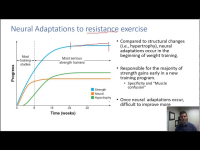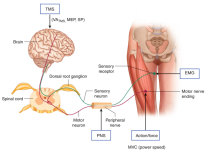- Messages
- 3,964
- Reaction score
- 1,745
- Points
- 113
Neural adaptations drive performance surges before visible muscle growth occurs. Your brain optimizes motor unit recruitment, enhancing force generation through strengthened neural pathways. Training teaches your nervous system to activate more muscle fibers simultaneously while improving coordination and movement efficiency. These adaptations happen faster than muscular changes, giving you early performance gains.
With progressive neural loading and consistent practice, you'll transform complex movements into automatic actions. Discover how strategically challenging your nervous system can release your untapped physical potential.How Your Brain Drives Physical Power
While many athletes focus primarily on building muscle mass, the true source of physical power lies in the complex communication network between your brain and muscles. This neuromuscular connection is where neural adaptations occur, transforming your training into performance enhancement.Your central nervous system orchestrates these improvements by optimizing how efficiently it recruits motor units. With consistent training, you'll develop more effective muscle activation patterns, allowing you to generate greater force with the same muscle mass.
These adaptations happen before visible muscle growth, explaining why beginners often experience significant strength gains within weeks.
Training Your Nervous System for Strength
Motor unit recruitment stands at the heart of neural strength development. When you lift weights or perform resistance exercises, you're not just building muscle. You're teaching your brain to activate more motor units simultaneously. This process enhances neural efficiency, allowing you to generate greater force without necessarily adding muscle mass.Through consistent strength training, synaptic plasticity occurs as neural pathways strengthen and communication between your brain and muscles improves. Your coordination develops as your nervous system learns to fire the right muscle fibers at the right time. The beauty of neural adaptations is their rapid response.
You'll notice strength gains within days or weeks as your body optimizes motor unit recruitment patterns, long before visible muscle growth appears.
Rewiring Pathways for Enhanced Athletic Performance
Beyond simple motor unit recruitment, neural plasticity represents the brain's remarkable ability to reorganize itself throughout an athlete's training journey. Your brain constantly rewires its neural connections in response to repeated training stimuli, forming stronger pathways that enhance skill acquisition and movement efficiency.This adaptability allows you to transform from a novice into a skilled performer. When you practice consistently, your nervous system creates integrated movement patterns that require less conscious effort and energy expenditure. What once demanded your full attention becomes second nature as neural circuits optimize their firing sequences.
The implications are profound. You'll execute techniques with greater precision, adapt to changing competitive environments faster, and recover more efficiently between efforts. Neural plasticity doesn't just improve performance; it fundamentally transforms how your body responds to athletic demands.
Brain-Muscle Synchronization for Movement Efficiency
As your training advances, the communication between your brain and muscles undergoes remarkable refinement, creating what experts call neuromuscular synchronization. This optimization within your neuromuscular system enables you to generate more force with less effort.Your brain improves by increasing the firing rate of motor neurons and enhancing recruitment of muscle fibers. You'll notice this synchronization when movements that once required intense concentration become automatic and efficient.
This refined brain-muscle connection doesn't just boost strength. It dramatically improves endurance by reducing unnecessary muscle activation. Your body's response becomes precisely calibrated to the task at hand, eliminating wasted energy and movement. The result? You'll perform better while using less energy, allowing for longer training sessions and faster recovery.
Progressive Neural Loading
While most training programs focus on increasing weight or repetitions, progressive neural loading takes a more sophisticated approach by systematically challenging your nervous system to adapt. This strategy manipulates variables like movement complexity, speed, and rest periods to maximize neural stimulation without overwhelming recovery capacity.You'll see peak results by gradually introducing novel movement patterns that demand heightened concentration and coordination. Your brain forms stronger neural pathways through this deliberate learning process, improving signal transmission between your central nervous system and muscles.
To implement this effectively, vary your training stimuli. Incorporate unstable surfaces, change movement tempos, or add cognitive challenges during exercises. Remember that neural adaptations occur faster than muscular ones, so you can progress to difficulty before physical fatigue becomes limiting.



